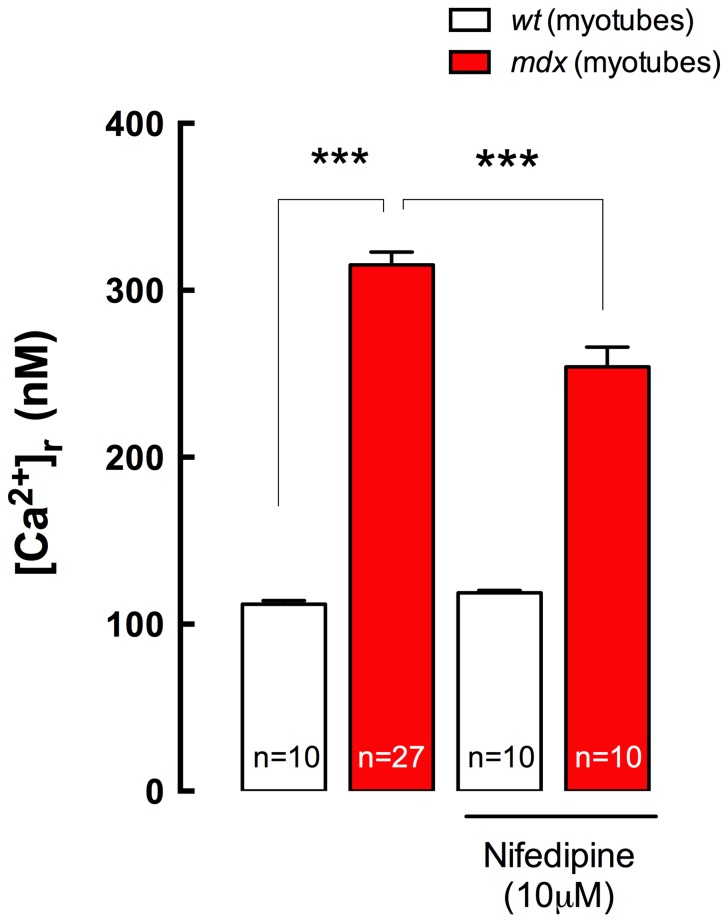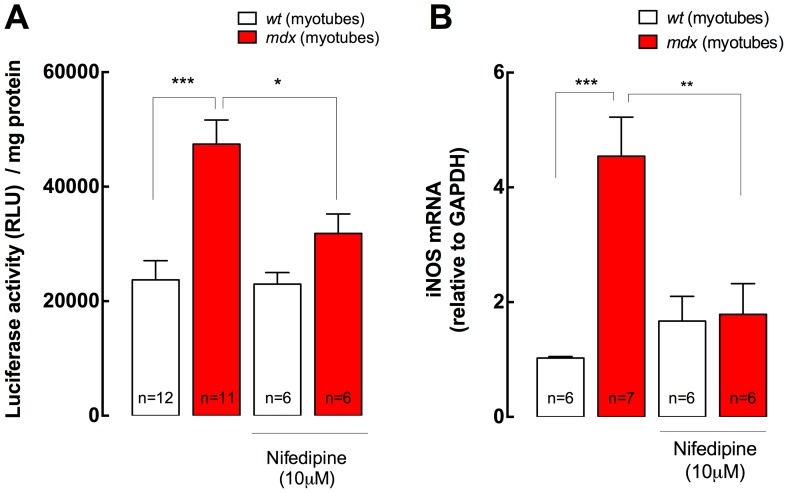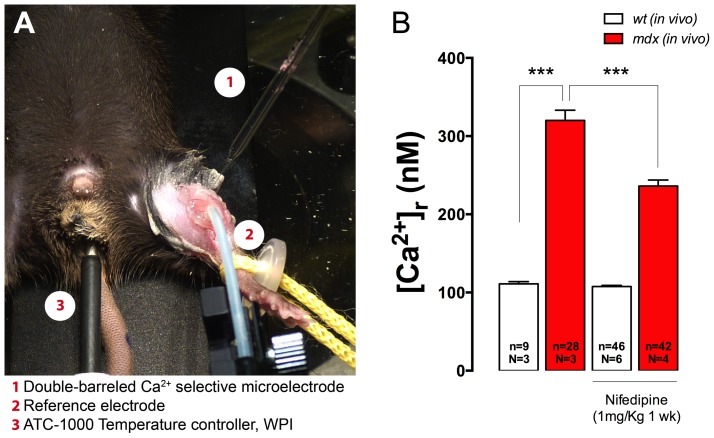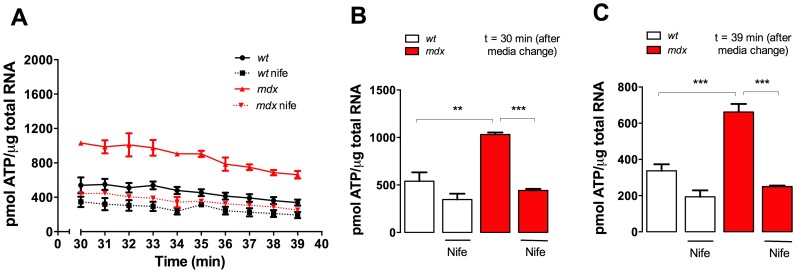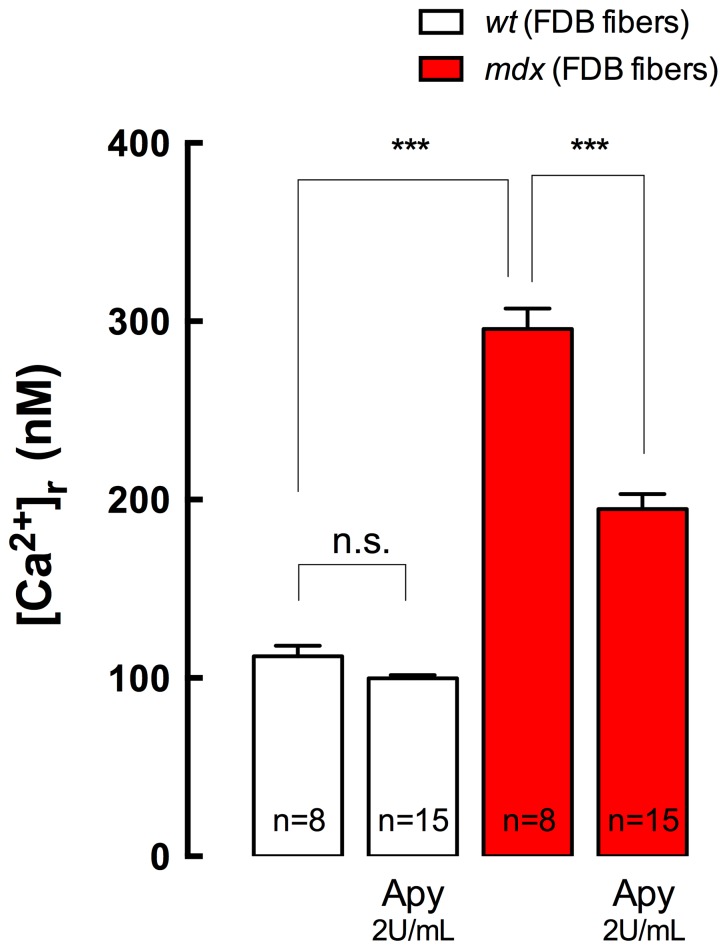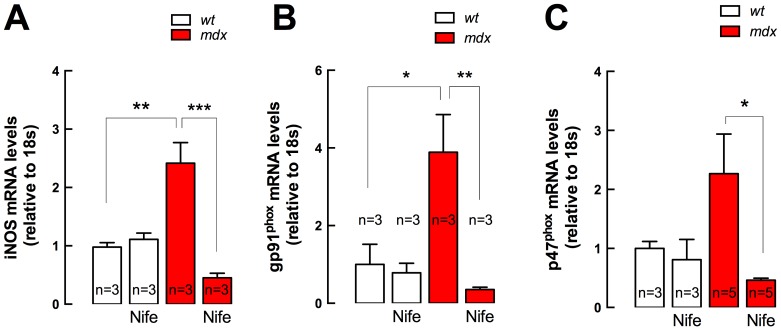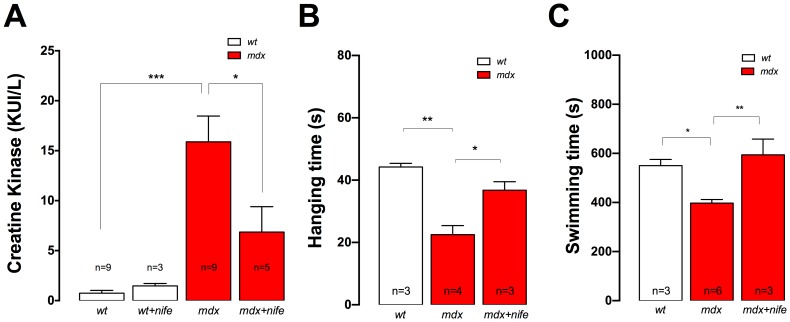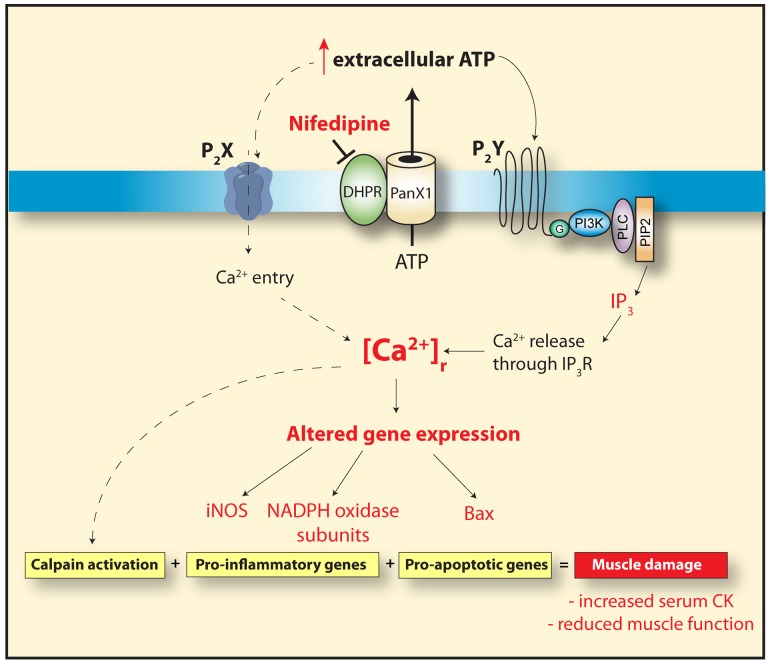Abstract
Duchenne Muscular Dystrophy (DMD) is a recessive X-linked genetic disease, caused by mutations in the gene encoding dystrophin. DMD is characterized in humans and in mdx mice by a severe and progressive destruction of muscle fibers, inflammation, oxidative/nitrosative stress, and cell death. In mdx muscle fibers, we have shown that basal ATP release is increased and that extracellular ATP stimulation is pro-apoptotic. In normal fibers, depolarization-induced ATP release is blocked by nifedipine, leading us to study the potential therapeutic effect of nifedipine in mdx muscles and its relation with extracellular ATP signaling. Acute exposure to nifedipine (10 µM) decreased [Ca2+]r, NF-κB activity and iNOS expression in mdx myotubes. In addition, 6-week-old mdx mice were treated with daily intraperitoneal injections of nifedipine, 1 mg/Kg for 1 week. This treatment lowered the [Ca2+]r measured in vivo in the mdx vastus lateralis. We demonstrated that extracellular ATP levels were higher in adult mdx flexor digitorum brevis (FDB) fibers and can be significantly reduced after 1 week of treatment with nifedipine. Interestingly, acute treatment of mdx FDB fibers with apyrase, an enzyme that completely degrades extracellular ATP to AMP, reduced [Ca2+]r to a similar extent as was seen in FDB fibers after 1-week of nifedipine treatment. Moreover, we demonstrated that nifedipine treatment reduced mRNA levels of pro-oxidative/nitrosative (iNOS and gp91phox/p47phox NOX2 subunits) and pro-apoptotic (Bax) genes in mdx diaphragm muscles and lowered serum creatine kinase (CK) levels. In addition, nifedipine treatment increased muscle strength assessed by the inverted grip-hanging test and exercise tolerance measured with forced swimming test in mdx mice. We hypothesize that nifedipine reduces basal ATP release, thereby decreasing purinergic receptor activation, which in turn reduces [Ca2+]r in mdx skeletal muscle cells. The results in this work open new perspectives towards possible targets for pharmacological approaches to treat DMD.
Introduction
Duchenne muscular dystrophy (DMD) is a severe neuromuscular disorder characterized by the absence of the dystrophin protein and is the most common form of muscular dystrophy with a frequency of 1 in 3500 male births [1]. DMD is caused by a recessive X-linked mutation in dystrophin gene located to Xp21 [2]. Usually patients lose the ability to walk between 6–12 years old due to severe muscle damage and contractures that results in wheelchair dependence [1]. Since DMD is a progressive disease, most patients die in their twenties due either to respiratory failure or cardiac dysfunction [3].
Resting intracellular calcium concentration ([Ca2+]r) is elevated in myotubes from mdx mice, a murine model for DMD [4]. This increased [Ca2+]r depends on sarcolemmal Ca2+ entry, as well as Ca2+ leak from sarcoplasmatic reticulum (SR), through type 1 ryanodine receptors (RyR1) and inositol tri-phosphate receptors (IP3R). In turn, elevated [Ca2+]r modulates NF-κB activation, leading to an up-regulation of inducible nitric oxide synthase (iNOS) in dystrophic myotubes [4].
The L-type voltage gated Ca2+ channels (Dihydropyridine receptors, DHPRs) are also implicated in DMD pathology [5]–[7]. Their roles as voltage sensors for both excitation-contraction and excitation-transcription coupling, and as their role as L-type Ca2+ channels in skeletal muscle cells, make them key regulators of intracellular [Ca2+] [8]–[10]. The DHPR is also an important modulator of ATP release through Pannexin1 channels in skeletal muscle fibers [9], [10]. ATP release elicited by electrical stimuli is blocked with the DHPR antagonist nifedipine as well as with the agonist (−)S-BayK 8644 in FDB fibers [10], suggesting that DHPR could directly control ATP release and that this event is independent of L-type current. An interaction between dystrophin and DHPR has been proposed in transverse tubular system of skeletal muscle fibers [6], [11], suggesting that there is DHPR dysregulation in dystrophic skeletal muscle cells. More recently, we showed that basal levels of ATP release are importantly increased in mdx muscle fibers [12]. In dystrophic fibers, extracellular ATP stimulation was pro-apoptotic, inducing the transcription of Bax, BIM and PUMA and increasing the levels of activated Bax and cytosolic cytochrome C [12]. These data suggest the potential for involvement of the ATP pathway in the activation of mechanisms related with cell death in muscular dystrophy, opening new perspectives towards possible targets for pharmacological therapies.
A double-blinded controlled clinical trial with nifedipine was carried out in 1987, and showed that there was no significant beneficial effect of nifedipine treatment [13]. In this study, patient selection was restricted to semiology and classical human genetics, since dystrophin was not cloned until 1987 [2]. DMD has been considered stereotyped in its clinical presentation, evolution and severity [14]. However, an inverse correlation between severity of disease and residual amount of dystrophin (related to different mutations) has been found [15]. More recently, a retrospective, single institution, long-term (>10 years) study was done in 75 DMD patients with a complete lack of dystrophin (determined by western blot) and genotyping, showed that DMD can be divided into 4 sub-phenotypes with different cognitive and motor outcomes [16], showing the complexity and heterogeneity of DMD.
Based on our previous results showing that extracellular ATP levels are elevated in mdx fibers and that ATP stimulation is pro-apoptotic, here we revisited the potential therapeutic effect of this drug in the mdx mouse model. In the present study, we found that acute treatment of mdx myotubes with nifedipine reduced [Ca2+]r, NF-κB activity and iNOS expression. Likewise, intraperitoneal injections of nifedipine for 1 week, reduced in vivo [Ca2+]r in vastus lateralis muscles, decreased serum creatine kinase levels and increased in vivo muscle strength in mdx mice. In FDB muscle fibers isolated from the same nifedipine treated mdx mice, basal ATP release was reduced and the gene expression of pro-oxidative and pro-apoptotic genes in diaphragm (the most seriously affected muscle) were down-regulated. The present findings demonstrate that nifedipine treatment can effectively modify the observed changes associated with muscle pathology in mdx mice and opens a new pharmacologic approach for treatment of patients with DMD.
Materials and Methods
Myotube Cultures
Primary myoblasts were isolated from 5–6 week old male wild type C57BL/6 and mdx mice and myotubes were differentiated as described previously [4], [17].
Adult FDB Fiber Isolation
Flexor digitorum brevis (FDB) muscles were dissected from 5–6 week old male mice and intact muscle fibers were obtained by enzymatic digestion of the whole muscle with collagenase type 4 (Worthington, Lakewood, NJ) for 90 min at 37°C followed by mechanical dissociation with fire polished Pasteur pipettes. Isolated fibers were seeded in matrigel-coated dishes in DMEM supplemented with 10% horse serum and used for experimentation 20–24 hours after isolation.
Drug Treatment Protocol
Male 5–6 week-old wt and mdx mice were injected daily for 1 week with either nifedipine solution (1 mg/Kg body weight) or saline intraperitoneally. Nifedipine (Sigma-Aldrich) solution was prepared in dark at 17 mg/mL in absolute ethanol and then was diluted in sterile saline solution (0.9% NaCl) at 0.2 mg/mL for injections.
Determination of [Ca2+]r
Double-barreled Ca2+-selective microelectrodes were prepared and calibrated as previously described [4]. Pulled microelectrodes were backfilled with the neutral carrier ETH 129 (Fluka-Sigma-Aldrich) and then with pCa7 solution. Only those electrodes with a linear relationship between pCa3 and pCa7 (Nernstian response, 29.5 mV and 30 mV per pCa unit at 23°C and 37°C, respectively) were used experimentally.
Myotubes or muscle fibers were impaled with the double-barreled Ca2+ selective microelectrodes and potentials were recorded via high impedance amplifier (WPI Duo-773) [18]. [Ca2+]r measurements in myotubes were made with or without nifedipine (10 µM) in Krebs-Ringer solution (in mM: 140 NaCl, 5 KCl, 2.5 CaCl2, 1 MgSO4, 5 glucose, and 10 Hepes/Tris, pH 7.4) at 23°C, as previously described [4].
The measurements of [Ca2+]r in muscle fibers were done in vivo in the vastus lateralis. Mice were anesthetized with ketamine 100 mg/Kg and xylazine 5 mg/Kg and kept euthermic with a feedback-heating pad (ATC-1000 Temperature controller, WPI, Sarasota, FL). A small incision was made in the skin in the anterior part of the left leg, the vastus lateralis muscle was identified and fascia was partially removed. The superficial fibers were exposed and locally perfused with Krebs Ringer solution.
Measurements of [Ca2+]r in isolated adult FDB fibers were done after fibers were incubated in Krebs Ringer solution with or without apyrase 2 U/mL (grade VII from potato, Sigma-Aldrich) for 10 min at room temperature.
NF-κB Luciferase Reporter Activity
Both wt and mdx myoblasts were transduced with a lentivirus containing 5 tandem NF-κB binding site repeats cloned upstream of a luciferase reporter gene and populations that stably expressed the transgene were selected using G418, as described previously [4]. Myoblasts stably expressing this reporter were completely normal and differentiated into myotubes after 3–4 days similar to untransduced cells. Myotubes were treated with or without nifedipine for 6 h in differentiation media. Luciferase activity was determined using a dual-luciferase reporter assay system (Promega) according to the manufacturer’s instructions, and light detection was carried out in a Berthold F12 luminometer. Results were normalized with total protein and the relations “luciferase activity/mg protein” were shown.
mRNA Quantitation
Total RNA was isolated from myotubes or diaphragm muscles from both the nifedipine- or saline-treated groups with TRIzol® reagent (Invitrogen) according to the manufacturer’s protocol. cDNA was prepared by reverse transcription (RT) reaction of 1 µg of total RNA using random primers. Real time PCR was performed as previously described [4] using the following primers:
bax 5′- GCTGACATGTTTGCTGATGG-3′ and 5′-GATCAGCTCGGGCACTTTAG-3′ bim 5′-CGACAGTCTCAGGAGGAACC-3′ and 5′-CATTTGCAAACACCCTCCTT-3′ gp91phox 5′-TCACATCCTCTACCAAAACC-3′ and 5′-CCTTTATTTTTCCCCATTCT-3′ p47phox 5′-AGAACAGAGTCATCCCACAC-3′ and 5′-GCTACGTTATTCTTGCCATC-3′ iNOS 5′-CAGCTCAAGAGCCAGAAACG-3′ and 5′-TTACTCAGTGCCAGAAGCTG-3′ gapdh 5′-CTCATGACCACAGTCCATGC-3′ and 5′-TTCAGCTCTGGGATGACCTT-3′ 18S rRNA 5′-GGGCCCGAAGCGTTTACTTT-3′ and 5′-TTGCGCCGGTCCAAGAATTT-3′.
ATP Detection Using a Luciferin/Luciferase Assay
FDB fibers from nifedipine- and saline-treated mice were prepared as described above. Because media replacement causes a mechanical stimulus that itself induces ATP release [19], [20], we measured ATP release for up to 9 min beginning 30 min after media change. ATP concentrations were measured with the CellTiter-Glo® Luminescent Cell Viability Assay (Promega, Madison, WI, USA) as reported [9]. Data were calculated as pmol extracellular ATP/µg total RNA. Normalization by total RNA instead of total protein was chosen because fibers were seeded on a Matrigel-coated dish (containing a large amount of protein), which may affect the protein determination associated only to fibers.
Serum Creatine Kinase Determinations
Blood samples were obtained by cardiac puncture in anesthetized mice. Blood was collected in a sterile test tube, allowed to clot on ice for 30 min and then centrifuged at 3000 rpm for 10 minutes. Creatine kinase (CK) levels were determined using the UV-kinetic method (Teco Diagnostics) according to the manufacturer instructions. ΔAbs/min were used to calculate CK enzymatic activity and the results were expressed as International Kilo Units per liter (KUI/L).
Inverted Grid-hanging Test
Muscle strength of mouse limbs was tested with an inverted grid-hanging test [21]. Mice were placed individually on the center of a 21×21 cm wire grid (wire width ≈0.1 cm and spacing 0.5 cm), mounted 35 cm above a table. After gently inverting the grid, the mouse hanging time was recorded (grip latency). This procedure was repeated three times and the average hanging time values were calculated for each mouse.
Forced Swimming Test
A 1-liter beaker (11 cm diameter and 15 cm height) filled with water (23°C) was used as swimming pool to assess the exercise tolerance of saline- and nifedipine-treated mice [22]. First, a weight (10% of their body weight) was attached to the tail of a mouse, which was then gently placed in the water, and the time at which the mouse was unable to maintain complete buoyancy was recorded. At this time the mice were immediately removed from the swimming pool, dried gently with paper towels and returned to their cages.
Statistical Analysis
Data of n experiments were expressed as mean ± S.E.M. The significance of difference among treatments was evaluated using a two-tailed t test for unpaired data or ANOVA- followed by Tukey’s t-test. A P value <0.05 was considered statistically significant.
Ethics Approval
All procedures for animal experimentation were done in accordance with guidelines approved by the Bioethical Committee at the Facultad de Medicina, Universidad de Chile and the IACUCs at Harvard Medical School and University of California at Davis.
Results
Nifedipine Reduces [Ca2+]r in Dystrophic mdx Myotubes
Myotubes were incubated in Krebs Ringer solution with or without nifedipine (10 µM) for 10 min and [Ca2+]r was measured with Ca2+ selective microelectrodes, in both wt and mdx myotubes. [Ca2+]r observed in mdx myotubes was significantly higher compared to wt myotubes (315±8 vs 112±2 nM P<0.001) (Figure 1). There was a significant reduction in the [Ca2+]r in nifedipine-treated mdx myotubes compared with untreated mdx myotubes (254±12, P<0.001). Nifedipine treatment did not modify [Ca2+]r in wt myotubes (119±1 nM, P>0.05).
Figure 1. Nifedipine incubation reduces [Ca2+]r in mdx myotubes.
Myotubes were incubated with 10 µM Nifedipine for 10 min at room temperature in Krebs Ringer solution and [Ca2+]r was measured using double-barreled Ca2+ selective microelectrodes. Data are expressed as mean ± S.E.M. Wt (n = 10), mdx (n = 27), Wt+Nife (n = 10) and mdx+Nife (n = 10). ***P<0.001, ANOVA-Tukey’s.
NF-κB Activity and iNOS Expression were Reduced After Nifedipine Incubation
We previously reported that the increases in NF-κB activity and iNOS expression are modulated by [Ca2+]r in mdx myotubes [4]. To study the effect of nifedipine treatment in NF-κB activity and iNOS expression, we used a NF-κB luciferase reporter and real time PCR, respectively (see Materials and Methods). After incubation with nifedipine (10 µM, 6 h) NF-κB activity was reduced by 33% (P<0.05) and iNOS mRNA levels were diminished by 61% (P<0.01) in mdx myotubes, without any significant effect in wt myotubes (P>0.05) (Figure 2).
Figure 2. NF-κB activity and iNOS expression in both wt and mdx myotubes.
A. NF-κB activity was studied with a luciferase reporter. Nifedipine treatment (10 µM for 6 h) reduced NF-κB activity in mdx, without any significant effect in wt myotubes (n = 6–12). B. mRNA levels of iNOS were determined by real time PCR after 6 h of nifedipine treatment (10 µM) (n = 6–7). Data are expressed as mean ± S.E.M., *P<0.05, **P<0.01, ***P<0.001, ANOVA-Tukey’s.
Nifedipine Decreases the [Ca2+]r in vivo in mdx Muscles
To establish if nifedipine can reduce [Ca2+]r in vivo, both wt and mdx mice were injected intraperitoneally daily for 1 week with either 1 mg/Kg nifedipine solution or saline. [Ca2+]r measured in vivo in the superficial fibers of vastus lateralis muscles was significantly higher in mdx muscles compared with wt muscles in the saline treated group (Figure 3, 320±13 vs 111±3 nM, P<0.001). Nifedipine treatment was able to significantly reduce [Ca2+]r in mdx mice (236±8 nM, P<0.001), but had no effect in wt muscles (108±1 nM, P>0.05).
Figure 3. Nifedipine treatment reduces muscle [Ca2+]r in vivo in mdx mice.
Mice were treated with daily intraperitoneal injections of nifedipine 1/Kg for 1-week or saline. A. Experimental setup to measure [Ca2+]r in vivo with Ca2+ selective microelectrodes in vastus lateralis muscle. B. Averaged data from [Ca2+]r determinations with or without nifedipine treatment. Data are expressed as mean ± S.E.M. from n fibers in N mice, ***P<0.001, ANOVA-Tukey’s.
Nifedipine Treatment Reduces ATP Release in Adult Fibers
Recently, we reported that depolarization-induced ATP release is modulated by DHPR activity and can be blocked in skeletal muscle cells by nifedipine [10]. Moreover, extracellular ATP levels are higher at resting conditions in mdx skeletal muscle fibers [12]. It is very well established that extracellular ATP can signal through purinergic receptors and modulate the intracellular Ca2+ concentration [23]. In order to establish a correlation between extracellular ATP and the alterations in the [Ca2+]r, we measured ATP release in isolated FDB fibers from both wt and mdx mice after 1-week of nifedipine or saline treatment. Because media replacement causes a mechanical stimulus that itself induces ATP release [19], [20], we measured ATP release after 30 min of media change and then up to 9 min. ATP release from mdx fibers was higher compared to wt fibers at every studied time point (Figure 4A). Nifedipine treatment reduced ATP release in both wt and mdx fibers, with a more pronounced effect in mdx fibers. At t = 30 min after media change average extracellular ATP in fibers from saline-treated mdx mice was higher than in saline-treated wt fibers (1031±22 vs 540±93 pmol ATP/µg RNA), P<0.01) (Figure 4B). ATP release was significantly decreased in fibers isolated from nifedipine-treated mdx (442±18 pmol ATP/µg RNA, P<0.001) compared to untreated mdx fibers. Similar results were observed after 9 min (Figure 4C), showing that extracellular ATP levels were higher in mdx fibers but can be diminished near to wt levels after 1-week of nifedipine treatment.
Figure 4. Extracellular ATP concentration in FDB fibers isolated from either nifedipine- or saline-treated wt and mdx mice.
A. Time course of extracellular ATP levels after media change. ATP concentration was measured with CellTiter-Glo® Luminescent Cell Viability Assay. Average extracellular ATP at 30 min (B) and at 39 min (C) after media change are shown in the figure. Data are expressed as mean ± S.E.M. FDB fibers were cultured from n = mice are indicated in the figure. **P<0.01, ***P<0.001, ANOVA-Tukey’s.
Degradation of Extracellular ATP Reduces [Ca2+]r in mdx Adult Fibers
In order to determine the participation of extracellular ATP on [Ca2+]r in adult mdx fibers, we treated isolated FDB fibers with apyrase (2 U/mL) in Krebs Ringer solution for 10 min. Apyrase is an enzyme that rapidly metabolizes extracellular ATP to AMP [9]. Apyrase treatment significantly reduced [Ca2+]r from 296±11 to 195±8 nM (P<0.001) in mdx fibers, without any significant effect in wt fibers (112±6 to 100±2 nM, P>0.05) (Figure 5).
Figure 5. Apyrase treatment reduces [Ca2+]r in FDB adult fibers.
Adult fibers were isolated from wt and mdx mice and incubated in Krebs Ringer solution with or without apyrase (2 U/mL) for 10 min at room temperature. [Ca2+]r was determined by double-barreled Ca2+ selective microelectrodes. Data are expressed as mean ± S.E.M. from n fibers (indicated in the figure) from three different cultures. n.s, no significant difference, ***P<0.001, ANOVA-Tukey’s.
NADPH Oxidase Subunits and iNOS Expression in mdx Mice
Dystrophic muscles are characterized by an increase in pro-oxidative gene expression, such as iNOS and NADPH oxidase subunits (gp91phox, p67phox and rac1) [4], [24], [25]. Because the diaphragm has been described as the most severely affected muscle in the mdx mouse [26] it was used to determine the antioxidant effects of nifedipine treatment. For these studies we determined mRNA levels of iNOS and the NADPH oxidase subunits gp91phox and p47phox, from whole diaphragm lysates using real time PCR. We found that iNOS mRNA levels were 2.4-fold and gp91phox were 3.9-fold higher in mdx diaphragms compared to wt, with no significant difference in the expression of p47phox between the two groups (Figure 6). Nifedipine treatment reduced the mRNA levels of iNOS, gp91phox and p47phox in mdx diaphragms by 86% (P<0.001), 91% (P<0.01) and 80% (P<0.05), respectively, with no significant effect in wt muscles.
Figure 6. iNOS and NADPH oxidase subunits gene expression in diaphragm muscles.
Diaphragms were dissected from nifedipine- and saline-treated mice and mRNA levels were assessed by real time PCR. A. iNOS, B., gp91phox and C. p47phox expression. Data are expressed as mean ± S.E.M. Diaphragms were obtained from n = mice as indicated in the figure. *P<0.05, **P<0.01, ***P<0.001, ANOVA-Tukey’s.
Nifedipine Treatment Normalizes Pro-apoptotic Genes Expression in mdx Mice
Necrosis is probably one of the major contributors to DMD pathology [27]. However, there is some evidence that suggests that apoptotic pathways could also be important [28], [29]. To determine if nifedipine can modify pro-apoptotic gene expression, we determined mRNA levels of both Bax and BIM in diaphragm muscles using real-time PCR. Bax mRNA levels were higher in mdx compared with wt mice (2.0-fold, P<0.05) (Figure 7) and nifedipine administration significantly diminished mRNA levels of Bax in mdx diaphragm by 73% (P<0.001) with no significant effect in wt diaphragm. We did not find any differences in BIM mRNA levels between any of the studied groups.
Figure 7. Bax and BIM gene expression in diaphragm muscles.
Diaphragms were dissected from nifedipine- and saline-treated mice and mRNA levels were assessed by real time PCR. A. Bax, B. BIM mRNA levels. Data are expressed as mean ± S.E.M. Diaphragms were obtained from n = mice as indicated in the figure, *P<0.05, ***P<0.001, ANOVA-Tukey’s.
Nifedipine Treatment Diminishes Serum CK Levels and Improves Muscle Strength in mdx Mice
To elucidate whether nifedipine treatment could reduce muscle damage, we measured serum CK levels in both wt and mdx mice after 1 week of either saline or nifedipine treatment. CK levels were significantly higher in saline treated mdx mice relative to saline treated wt mice (15.9±2.6 vs 0.7±0.3 KUI/L, P<0.001) (Figure 8A). Nifedipine reduced CK levels in mdx mice (6.8±2.5 KUI/L, P<0.05), without any significant effect in wt mice (1.5±0.2 KUI/L, P>0.05).
Figure 8. Nifedipine treatment reduced serum CK and increases muscle function in mdx mice.
A. Blood samples were collected by cardiac puncture under anesthesia from both nifedipine- or saline-treated mice. CK activities were determined by the UV kinetic method. B. Averaged hanging time obtained in the inverted grid-hanging test in saline- and nifedipine treated mice. C. Averaged swimming time obtained in the forced swimming test in nifedipine- or saline- treated mdx mice. Data are expressed as mean ± S.E.M. n = mice is indicated in the figure, *P<0.05, **P<0.01, ***P<0.001 ANOVA-Tukey’s.
In order to determine whether nifedipine treatment might increase muscle strength we used the inverted grid-hanging test and the forced swimming test. Mice were treated daily with nifedipine (1 mg/Kg) or saline for 1 week, and the functional test was performed one day after cessation of treatment. Saline treated mdx mice had a significantly shorter hanging time compared to wt mice (23±3 s vs 44±1 s, P<0.01 Figure 8B). Nifedipine treatment increased the mdx hanging time by 61% (37±3 s, P<0.05 compared to saline-treated mice (Figure 8B).
Similar results were observed using the forced swimming test. Under this experimental condition, wt swimming time was significantly higher compared to saline-treated mdx mice (550±25 s vs 398±15 s, P<0.05, Figure 8C). In this case nifedipine treatment for 1 week normalized the swimming time in mdx mice increasing it to 594±64 s (P<0.01 compared to saline-treated mice, Figure 8C).
Discussion
Our data show that [Ca2+]r was elevated in mdx myotubes and to a similar extent in adult skeletal muscle fibers from mdx mice. Acute exposure of mdx myotubes to nifedipine decreased [Ca2+]r, NF-κB activity and iNOS expression. Likewise, in mdx mice, nifedipine treatment for 1-week lowered in vivo [Ca2+]r in the vastus lateralis, reduced ATP release in FDB fibers, diminished mRNA levels of pro-oxidative/apoptotic genes in the diaphragm, lowered serum CK levels and improved muscle function as assessed by both inverted grid-hanging test and forced swimming test.
Although still controversial, it is generally accepted that dystrophic skeletal muscle cells have elevated [Ca2+]r [4], [30]–[32]. Our data support these findings showing that [Ca2+]r was elevated in mdx myotubes and to a similar extent in skeletal muscles from mdx mice, measured either in isolated FDB fibers or determined in vivo, in anesthetized mice. Moreover, we showed that either acute nifedipine treatment of myotubes or chronic nifedipine treatment of mice for 1-week reduced [Ca2+]r. Nifedipine is known as specific inhibitor of the DHPR [33]. In addition to its role as an L-type Ca2+ channel the DHPR operates as voltage sensor for both excitation-contraction and excitation-transcription coupling in adult muscle fibers [8]–[10]. Dystrophic mdx skeletal muscle cells have a dysregulated excitation-contraction coupling as evidenced by reduced calcium transients evoked by single action potentials compared with wt fibers [34], [35]. This has been used to explain the muscle weakness observed in DMD patients. On the other hand, there is a controversy related to whether there are alterations of L-type Ca2+ currents in mdx muscles, with some studies showing normal maximum currents [5] while others show decreased maximum current [6], [7]. No differences have been found in charge movement between normal and dystrophic skeletal muscle fibers [5], [36]. In addition, a leftward-shift of the voltage dependence of L-type Ca2+ current has been described [5].
Our data showed that extracellular ATP levels were higher in mdx fibers compared to wt fibers. Chronic nifedipine treatment reduces ATP release in adult mdx FDB fibers to a level similar to wt fibers. Moreover, acute enzymatic ablation of extracellular ATP-ADP with apyrase treatment reduces the [Ca2+]r in mdx fibers from 296 nM to 195 nM, showing that elevated extracellular ATP is an important modulator of [Ca2+]r in mdx skeletal muscle fibers. Extracellular ATP can signal through P2X (inotropic) and P2Y (metabotropic) purinergic receptors [23], [37], the latter pathway leading to Ca2+ release through inositol tri-phosphate receptors (IP3R). We previously reported that IP3 levels were higher in both human DMD and mdx cell lines [38] and that either phospholipase C (U-73122) or IP3R (Xestospongin C) inhibition could significantly reduce [Ca2+]r in mdx myotubes [4].
Pannexin-1 channels are involved in ATP release after depolarization in myotubes and adult muscle fibers [9], [10]. Based on co-immunoprecipitation and a proximity ligation assay [10], an interaction between DHPR and Pannexin-1 channels has been proposed. Recently, we have shown that the DHPR is an important modulator of ATP release, and that it is necessary for fast-to-slow phenotype transition in FDB adult muscle fibers stimulated at 20 Hz [10]. ATP release through pannexin-1 channels observed after 20 Hz electrical stimulation of adult muscle fibers is inhibited by nifedipine [10], suggesting that the DHPR could directly control ATP release via Pannexin-1 channels.
Due to a chronic state of fiber injury, dystrophic muscle would be expected to contain high levels of extracellular ATP. In addition, ATP release to the extracellular medium was shown to be elevated in muscle fibers isolated from mdx mice [12]. Several alterations have been found in ATP signaling in dystrophic skeletal muscle cells. In an immortalized myoblast cell line derived from mdx mouse, addition of exogenous ATP to the media induced a large increase in cytosolic Ca2+ concentration compared with its wt counterpart [39]. This increased susceptibility to ATP was associated with changes in expression and function of P2X channels and to pathogenic Ca2+ entry in dystrophic muscles. Furthermore, enhanced expression of the P2X4 and P2X7 receptors have been related to macrophage invasion in mdx mice [40].
Here we determined the expression of iNOS and NADPH oxidase subunits in diaphragm, because this muscle has been described as the most severely affected muscle in the mdx mouse [26]. Nifedipine reduced iNOS, gp91phox and p47phox mRNA levels in mdx diaphragm after 1-week of treatment. We previously demonstrated that iNOS expression was higher in mdx myotubes which we attributed to an up-regulated NF-κB activity mediated by the elevated [Ca2+]r [4]. Nifedipine treatment reduced iNOS expression in diaphragm, likely due to the same mechanism.
Recently, it has been shown that dihydropyridines have anti-inflammatory and anti-oxidant effects. Nifedipine caused concentration-dependent inhibitory effects on sarcolemmal lipid peroxidation in vitro [41]. Toma et al, 2011 suggest that amlodipine, a third generation dihydropyridine L-type calcium channel blocker, may improve endothelial dysfunction in diabetics through anti-oxidant and anti-inflammatory mechanisms. The authors stimulated human endothelial cells with irreversible glycated low-density lipoproteins (AGE-LDL), as an in vitro model mimicking the diabetic condition. Their results show that amlodipine reduced the expression of NADPH oxidase subunits (p22phox and NOX4) and iNOS, and diminished oxidative/nitrosative stress. Moreover, amlodipine had anti-inflammatory effects reducing the activation of MCP-1, VCAM-1, p38 MAPK and NF-κB [42]. In another study, it has been shown that amlodipine (3 mg/kg/day) decrease the expression of NADPH subunits (p47phox and rac1), NADPH activity and the expression of inflammatory factor in atherosclerotic lesions [43].
Necrosis is probably the major contributor to DMD pathology [27]. However, there is some evidence that suggests that apoptotic pathways could also be important [28], [29]. We observed that nifedipine reduced significantly Bax expression in mdx diaphragms, suggestive of a protective anti-apoptotic effect. Bax was abundantly expressed in the mdx masseter muscles compared to wt muscles at 3 weeks after birth [29]. We have demonstrated that exogenous ATP increases mRNA levels of several pro-apoptotic genes in skeletal muscle fibers, including Bax, BIM and PUMA. Moreover, ATP induced Bax activation and cytochrome C release in mdx fibers, which is related with apoptotic cell death [12].
A previous double-blind controlled clinical trial with nifedipine did not demonstrate a beneficial therapeutic response on mean muscle strength, joint contractures, time-functional tests, pulmonary function, or creatine kinase levels in 105 patients between 3–27 years of age at the end of the study who were presumed to have DMD [13]. Patients were given nifedipine 0.75 mg/kg/day in three divided oral doses for 6 months and then 1.5–2 mg/Kg/day for the final 12 months of the study [13]. A total of 97 patients completed the trial. The power of the study to detect a difference between groups was calculated using the decrease of average muscle strength over time as the primary outcome measure. Average muscle strength score were calculated with a modified manual testing scale (MMT) [14] and the study had a power greater that 0.99 to detect a slowing of the illness to 25% of its original progression. The diagnostic criteria were based on semiology and classical human genetics, however three patients classified as Becker dystrophy were included in the study. Moreover the one patient aged 27 years old was considered to be unusual for DMD [44]. The data presented showed that the average muscle strength score as slightly improved without any significant difference. The trial used an unpaired analysis and it may have been more appropriate to use a paired analysis so that before and after changes in individuals could be compared [44].
As we mentioned before, there is an inverse correlation between severity of disease and dystrophin expression [15] and even patients with a complete lack of dystrophin DMD can be divided into 4 sub-phenotypes with different cognitive and motor outcomes [16]. This shows the high variability in the natural history of DMD. Phenotypic variations have shown to compromise results of clinical trials [45]. Desguerre et al, suggest that trials, which are in danger of being inconclusive due to lack of precise knowledge of DMD’s natural history, would strongly benefit from accurate selection of clinically homogeneous patient subsets [16].
High CK levels observed in DMD patients are attributed to an enhanced membrane permeability and muscle damage [46]. In our study, nifedipine treatment significantly reduced CK levels in mdx mice after 1-week, but did not normalize it. These data are supported by a study using verapamil, another L-type calcium channel blocker, which showed a significant reduction in the release of CK and LDH from diaphragm and gastrocnemius muscles [47]. In the previous nifedipine clinical trial, authors did not observe any significant difference in averaged CK levels after treatment, reporting that patients from nifedipine group had an average CK level of 2681 U/liter at the start and a value of 2045 U/liter at the end [13]. High levels of CK in DMD are well-known, and after a rise in infancy, they remain at high levels with an abrupt decrease at around 10 years old due to loss of muscle mass [48]. Thus averaged data from a broad age group could easily miss a significant difference when and if one existed.
Reduction of [Ca2+]r and in the expression of pro-oxidative/apoptotic proteins, could be beneficial to dystrophic muscles and may explain a reduction in muscle damage that a decrease in serum CK would indicate. Moreover, an increase in the hanging time and normalization of the forced swimming test were observed in nifedipine-treated mdx mice, demonstrating an increase in motor function, probably due to reduced muscle damage or increased regeneration. In summary, these results provide further evidence that [Ca2+]r is elevated in mdx muscles and this can be modulated in vivo by nifedipine administration through a reduction in basal ATP release from dystrophic fibers. Moreover, nifedipine treatment reduced pro-oxidative/apoptotic gene expression with the end result being less muscle damage as evidenced by a significant reduction of serum CK and an increased muscle strength in mdx mice (Figure 9). Our study used daily intraperitoneally doses of nifedipine (1 mg/Kg) for 1 week as compared to the clinical study, which used it for a longer time period via the oral route of administration. Moreover, our study was carried out in 5–6 week old mdx mice (necrosis/regeneration stage) compared to the clinical study that included patients at different stages of the disease (3–27 years old). Longer studies need to be carried out to assess the positive effects and pitfalls of nifedipine treatment studies in mdx mice. However, our results strongly suggest that blockers of the ATP signaling pathway should be tested in DMD patients, as they might be promising in palliating the disease and prolonging muscle function.
Figure 9. Proposed model for ATP-mediated effects in dystrophic skeletal muscle.
In dystrophic skeletal muscle fibers there is an increase in basal ATP release, through Pannexin1 channels that is modulated by the DHPR [12]. Extracellular ATP increases the [Ca2+]r in dystrophic muscle fibers through the activation of purinergic receptors (P2X, inotropic and P2Y, metabotropic). This leads to the expression of pro-apoptotic and pro-inflammatory genes, increasing the muscle damage observed in dystrophic skeletal muscle cells. Nifedipine treatment reduces the basal ATP release and reduces [Ca2+]r, resulting in less pro-inflammatory and pro-apoptotic gene expression and subsequently reduces muscle damage as indicated by a decrease in blood CK and an increase in muscle function assessed by the inverted grid-hanging test and the force swimming test.
Funding Statement
Fondo de Investigación Avanzado en Areas Prioritarias 15010006, Fondo Nacional de Desarrollo Científico y Tecnológico 1110467, ACT1111 and AFM14562 (EJ, MC), National Institutes of Health AR43140, AR052534 (PDA and JRL), Program U-INICIA VID 2011, grant U-INICIA 02/12M; University of Chile (MC) supported this work. FA and DV were recipients of a doctoral fellowship and a doctoral thesis support grants AT-24100066 (FA), AT-24110211 (DV) from Comisión Nacional de Ciencia y Tecnología (CONICYT). FA thanks Vicerrectoría Asuntos Académicos and MECESUP UCH0714 (Universidad de Chile) and REDES 120003 (CONICYT) for travel support. The funders had no role in study design, data collection and analysis, decision to publish, or preparation of the manuscript.
References
- 1. Blake DJ, Weir A, Newey SE, Davies KE (2002) Function and genetics of dystrophin and dystrophin-related proteins in muscle. Physiol Rev 82: 291–329. [DOI] [PubMed] [Google Scholar]
- 2. Koenig M, Hoffman EP, Bertelson CJ, Monaco AP, Feener C, et al. (1987) Complete cloning of the Duchenne muscular dystrophy (DMD) cDNA and preliminary genomic organization of the DMD gene in normal and affected individuals. Cell 50: 509–517. [DOI] [PubMed] [Google Scholar]
- 3. Emery AE (2002) The muscular dystrophies. Lancet 359: 687–695. [DOI] [PubMed] [Google Scholar]
- 4. Altamirano F, Lopez JR, Henriquez C, Molinski T, Allen PD, et al. (2012) Increased resting intracellular calcium modulates NF-kappaB-dependent inducible nitric-oxide synthase gene expression in dystrophic mdx skeletal myotubes. J Biol Chem 287: 20876–20887. [DOI] [PMC free article] [PubMed] [Google Scholar]
- 5. Collet C, Csernoch L, Jacquemond V (2003) Intramembrane charge movement and L-type calcium current in skeletal muscle fibers isolated from control and mdx mice. Biophys J 84: 251–265. [DOI] [PMC free article] [PubMed] [Google Scholar]
- 6. Friedrich O, von Wegner F, Chamberlain JS, Fink RH, Rohrbach P (2008) L-type Ca2+ channel function is linked to dystrophin expression in mammalian muscle. PLoS One 3: e1762. [DOI] [PMC free article] [PubMed] [Google Scholar]
- 7. Imbert N, Vandebrouck C, Duport G, Raymond G, Hassoni AA, et al. (2001) Calcium currents and transients in co-cultured contracting normal and Duchenne muscular dystrophy human myotubes. J Physiol 534: 343–355. [DOI] [PMC free article] [PubMed] [Google Scholar]
- 8. Tanabe T, Beam KG, Powell JA, Numa S (1988) Restoration of excitation-contraction coupling and slow calcium current in dysgenic muscle by dihydropyridine receptor complementary DNA. Nature 336: 134–139. [DOI] [PubMed] [Google Scholar]
- 9. Buvinic S, Almarza G, Bustamante M, Casas M, Lopez J, et al. (2009) ATP released by electrical stimuli elicits calcium transients and gene expression in skeletal muscle. J Biol Chem 284: 34490–34505. [DOI] [PMC free article] [PubMed] [Google Scholar]
- 10.Jorquera G, Altamirano F, Contreras-Ferrat A, Almarza G, Buvinic S, et al.. (2013) Cav1.1 controls frequency-dependent events regulating adult skeletal muscle plasticity. J Cell Sci. [DOI] [PubMed]
- 11. Knudson CM, Hoffman EP, Kahl SD, Kunkel LM, Campbell KP (1988) Evidence for the association of dystrophin with the transverse tubular system in skeletal muscle. J Biol Chem 263: 8480–8484. [PubMed] [Google Scholar]
- 12.Valladares D, Almarza G, Contreras A, Pavez M, Buvinic S, et al.. (2013) Electrical stimuli are anti-apoptotic in skeletal muscle via extracellular ATP. Alterations of this signal in mdx mice is a likely cause of dystrophy. PLoS One. In Press. [DOI] [PMC free article] [PubMed]
- 13. Moxley RT 3rd, Brooke MH, Fenichel GM, Mendell JR, Griggs RC, et al. (1987) Clinical investigation in Duchenne dystrophy. VI. Double-blind controlled trial of nifedipine. Muscle Nerve 10: 22–33. [DOI] [PubMed] [Google Scholar]
- 14. Brooke MH, Fenichel GM, Griggs RC, Mendell JR, Moxley R, et al. (1983) Clinical investigation in Duchenne dystrophy: 2. Determination of the “power” of therapeutic trials based on the natural history. Muscle Nerve 6: 91–103. [DOI] [PubMed] [Google Scholar]
- 15. Nicholson LV, Johnson MA, Bushby KM, Gardner-Medwin D, Curtis A, et al. (1993) Integrated study of 100 patients with Xp21 linked muscular dystrophy using clinical, genetic, immunochemical, and histopathological data. Part 3. Differential diagnosis and prognosis. J Med Genet 30: 745–751. [DOI] [PMC free article] [PubMed] [Google Scholar]
- 16. Desguerre I, Christov C, Mayer M, Zeller R, Becane HM, et al. (2009) Clinical heterogeneity of duchenne muscular dystrophy (DMD): definition of sub-phenotypes and predictive criteria by long-term follow-up. PLoS One 4: e4347. [DOI] [PMC free article] [PubMed] [Google Scholar]
- 17. Casas M, Altamirano F, Jaimovich E (2012) Measurement of calcium release due to inositol trisphosphate receptors in skeletal muscle. Methods Mol Biol 798: 383–393. [DOI] [PubMed] [Google Scholar]
- 18.Eltit JM, Ding X, Pessah IN, Allen PD, Lopez JR (2012) Nonspecific sarcolemmal cation channels are critical for the pathogenesis of malignant hyperthermia. FASEB J. [DOI] [PMC free article] [PubMed]
- 19. Ho CL, Yang CY, Lin WJ, Lin CH (2013) Ecto-Nucleoside Triphosphate Diphosphohydrolase 2 Modulates Local ATP-Induced Calcium Signaling in Human HaCaT Keratinocytes. PLoS One 8: e57666. [DOI] [PMC free article] [PubMed] [Google Scholar]
- 20. Yoshida H, Kobayashi D, Ohkubo S, Nakahata N (2006) ATP stimulates interleukin-6 production via P2Y receptors in human HaCaT keratinocytes. Eur J Pharmacol 540: 1–9. [DOI] [PubMed] [Google Scholar]
- 21. Kaja S, van de Ven RC, van Dijk JG, Verschuuren JJ, Arahata K, et al. (2007) Severely impaired neuromuscular synaptic transmission causes muscle weakness in the Cacna1a-mutant mouse rolling Nagoya. Eur J Neurosci 25: 2009–2020. [DOI] [PubMed] [Google Scholar]
- 22. Razani B, Wang XB, Engelman JA, Battista M, Lagaud G, et al. (2002) Caveolin-2-deficient mice show evidence of severe pulmonary dysfunction without disruption of caveolae. Mol Cell Biol 22: 2329–2344. [DOI] [PMC free article] [PubMed] [Google Scholar]
- 23. Burnstock G (2006) Purinergic P2 receptors as targets for novel analgesics. Pharmacol Ther 110: 433–454. [DOI] [PubMed] [Google Scholar]
- 24. Bellinger AM, Reiken S, Carlson C, Mongillo M, Liu X, et al. (2009) Hypernitrosylated ryanodine receptor calcium release channels are leaky in dystrophic muscle. Nat Med 15: 325–330. [DOI] [PMC free article] [PubMed] [Google Scholar]
- 25. Whitehead NP, Yeung EW, Froehner SC, Allen DG (2010) Skeletal muscle NADPH oxidase is increased and triggers stretch-induced damage in the mdx mouse. PLoS One 5: e15354. [DOI] [PMC free article] [PubMed] [Google Scholar]
- 26. Stedman HH, Sweeney HL, Shrager JB, Maguire HC, Panettieri RA, et al. (1991) The mdx mouse diaphragm reproduces the degenerative changes of Duchenne muscular dystrophy. Nature 352: 536–539. [DOI] [PubMed] [Google Scholar]
- 27. Miller JB, Girgenrath M (2006) The role of apoptosis in neuromuscular diseases and prospects for anti-apoptosis therapy. Trends Mol Med 12: 279–286. [DOI] [PubMed] [Google Scholar]
- 28. Tews DS, Goebel HH (1997) DNA-fragmentation and expression of apoptosis-related proteins in muscular dystrophies. Neuropathol Appl Neurobiol 23: 331–338. [PubMed] [Google Scholar]
- 29. Honda A, Abe S, Hiroki E, Honda H, Iwanuma O, et al. (2007) Activation of caspase 3, 9, 12, and Bax in masseter muscle of mdx mice during necrosis. J Muscle Res Cell Motil 28: 243–247. [DOI] [PubMed] [Google Scholar]
- 30. Allen DG, Gervasio OL, Yeung EW, Whitehead NP (2010) Calcium and the damage pathways in muscular dystrophy. Can J Physiol Pharmacol 88: 83–91. [DOI] [PubMed] [Google Scholar]
- 31. Lopez JR, Briceno LE, Sanchez V, Horvart D (1987) Myoplasmic (Ca2+) in Duchenne muscular dystrophy patients. Acta Cient Venez 38: 503–504. [PubMed] [Google Scholar]
- 32. Turner PR, Westwood T, Regen CM, Steinhardt RA (1988) Increased protein degradation results from elevated free calcium levels found in muscle from mdx mice. Nature 335: 735–738. [DOI] [PubMed] [Google Scholar]
- 33. Neuhaus R, Rosenthal R, Luttgau HC (1990) The effects of dihydropyridine derivatives on force and Ca2+ current in frog skeletal muscle fibres. J Physiol 427: 187–209. [DOI] [PMC free article] [PubMed] [Google Scholar]
- 34. Capote J, DiFranco M, Vergara JL (2010) Excitation-contraction coupling alterations in mdx and utrophin/dystrophin double knockout mice: a comparative study. Am J Physiol Cell Physiol 298: C1077–1086. [DOI] [PMC free article] [PubMed] [Google Scholar]
- 35. Woods CE, Novo D, DiFranco M, Vergara JL (2004) The action potential-evoked sarcoplasmic reticulum calcium release is impaired in mdx mouse muscle fibres. J Physiol 557: 59–75. [DOI] [PMC free article] [PubMed] [Google Scholar]
- 36. Hollingworth S, Marshall MW, Robson E (1990) Excitation contraction coupling in normal and mdx mice. Muscle Nerve 13: 16–20. [DOI] [PubMed] [Google Scholar]
- 37. Abbracchio MP, Burnstock G, Boeynaems JM, Barnard EA, Boyer JL, et al. (2006) International Union of Pharmacology LVIII: update on the P2Y G protein-coupled nucleotide receptors: from molecular mechanisms and pathophysiology to therapy. Pharmacol Rev 58: 281–341. [DOI] [PMC free article] [PubMed] [Google Scholar]
- 38. Liberona JL, Powell JA, Shenoi S, Petherbridge L, Caviedes R, et al. (1998) Differences in both inositol 1,4,5-trisphosphate mass and inositol 1,4,5-trisphosphate receptors between normal and dystrophic skeletal muscle cell lines. Muscle Nerve 21: 902–909. [DOI] [PubMed] [Google Scholar]
- 39. Yeung D, Zablocki K, Lien CF, Jiang T, Arkle S, et al. (2006) Increased susceptibility to ATP via alteration of P2X receptor function in dystrophic mdx mouse muscle cells. FASEB J 20: 610–620. [DOI] [PubMed] [Google Scholar]
- 40. Yeung D, Kharidia R, Brown SC, Gorecki DC (2004) Enhanced expression of the P2X4 receptor in Duchenne muscular dystrophy correlates with macrophage invasion. Neurobiol Dis 15: 212–220. [DOI] [PubMed] [Google Scholar]
- 41. Mak IT, Weglicki WB (1990) Comparative antioxidant activities of propranolol, nifedipine, verapamil, and diltiazem against sarcolemmal membrane lipid peroxidation. Circ Res 66: 1449–1452. [DOI] [PubMed] [Google Scholar]
- 42. Toma L, Stancu CS, Sanda GM, Sima AV (2011) Anti-oxidant and anti-inflammatory mechanisms of amlodipine action to improve endothelial cell dysfunction induced by irreversibly glycated LDL. Biochem Biophys Res Commun 411: 202–207. [DOI] [PubMed] [Google Scholar]
- 43. Yoshii T, Iwai M, Li Z, Chen R, Ide A, et al. (2006) Regression of atherosclerosis by amlodipine via anti-inflammatory and anti-oxidative stress actions. Hypertens Res 29: 457–466. [DOI] [PubMed] [Google Scholar]
- 44.Phillips MF, Quinlivan R (2008) Calcium antagonists for Duchenne muscular dystrophy. Cochrane Database Syst Rev: CD004571. [DOI] [PMC free article] [PubMed]
- 45. Escolar DM, Buyse G, Henricson E, Leshner R, Florence J, et al. (2005) CINRG randomized controlled trial of creatine and glutamine in Duchenne muscular dystrophy. Ann Neurol 58: 151–155. [DOI] [PubMed] [Google Scholar]
- 46. Ozawa E, Hagiwara Y, Yoshida M (1999) Creatine kinase, cell membrane and Duchenne muscular dystrophy. Mol Cell Biochem 190: 143–151. [PubMed] [Google Scholar]
- 47. Niebrój-Dobosz I, Lukasiuk M (1996) Release of Intracellular Enzymes from Skeletal Muscles and Diaphragm in Mdx Mice. European Journal of Translational Myology 6: 377–383. [Google Scholar]
- 48. Konagaya M, Takayanagi T (1986) Regularity in the change of serum creatine kinase level in Duchenne muscular dystrophy. A study with long-term follow-up cases. Jpn J Med 25: 2–8. [DOI] [PubMed] [Google Scholar]



